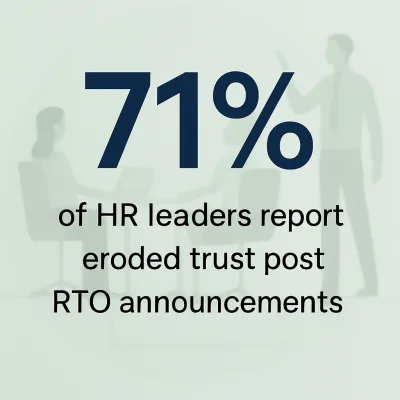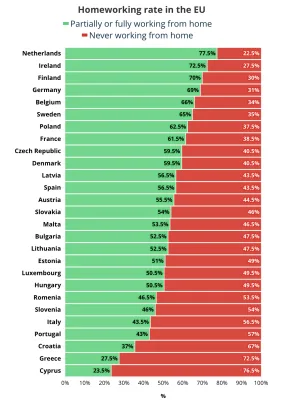Key Takeaway: Return-to-office mandates risk significant talent loss, with 53% of remote-capable employees willing to quit and 48% of European workers accepting pay cuts to maintain flexibility.
Last Updated: June 2025 | Reading Time: 6 minutes | Research Period: 2024-2025
Three years after the pandemic reshaped how we work, a quiet revolution is brewing in offices across Europe and beyond. It’s not about productivity metrics or quarterly reports—it’s about trust, autonomy, and the fundamental question of what work means in 2025.
Executive Summary: The RTO Crisis in Numbers
 Employee Response to Full RTO Mandates:
Employee Response to Full RTO Mandates:
- 53% would actively seek new employment
- 41% would comply under protest
- 14% would quit immediately
- 48% of European workers would accept 8% pay cuts to maintain flexibility 6 3
Business Impact:
- 80% of companies lost talent due to RTO mandates
- 13% higher turnover rates in firms with strict policies
- 71% of HR leaders report eroded trust post-RTO announcements
Regional Variations:
- Europe: 55-65% average office attendance 7
- West Coast US: ~30% office occupancy
- East Coast US: ~50% office occupancy
- Asia: 85-90% office attendance
I recently spoke with Sarah, a senior marketing manager in Amsterdam, who described her company’s return-to-office mandate as feeling like “a step backwards in time.” After two years of successfully managing her team remotely while caring for her elderly mother, she was told she needed to be in the office four days a week—no exceptions, no flexibility.
Sarah isn’t alone. Across Europe and globally, we’re witnessing a growing backlash against rigid return-to-office (RTO) policies that threatens to undo the trust and productivity gains many organizations worked so hard to build during the remote work era.

The Numbers Don’t Lie: Employees Are Ready to Walk
Research Finding: According to 2024-2025 global workplace studies, the majority of employees will resist full return-to-office mandates.
The data emerging from 2024 and early 2025 paints a stark picture for employers considering inflexible RTO mandates. According to recent global research, 53% of remote-capable employees would actively seek new employment if forced to return to the office full-time. Even more telling, 41% would comply under protest while 14% would quit immediately.
European Market Specifics: In Europe specifically, the attachment to flexible work runs even deeper. A striking 48% of hybrid and remote workers said they would accept an 8% pay cut just to maintain their flexibility. Think about that for a moment—nearly half of Europe’s hybrid workforce values their autonomy so highly they’re willing to sacrifice real income to preserve it.
Business Consequences: This isn’t just employee posturing. Companies are feeling the real consequences: 80% of organizations globally admit they’ve lost talent due to RTO mandates, with turnover rates running 13% higher in firms with strict return-to-office policies.
Europe’s Unique Work Culture Makes RTO Even Riskier
Key Insight: European work-life balance expectations make return-to-office mandates particularly disruptive compared to other regions. 2
What makes the European context particularly fascinating is how deeply embedded work-life balance has become in the cultural fabric. Unlike their American counterparts, European workers haven’t just adapted to flexibility—they’ve come to expect it as a fundamental right. 11
Current European Office Attendance Patterns:
- Average attendance: 55-65% (vs. 30-50% US West Coast)
- Represents new cultural equilibrium around work-life integration
- Reflects statutory leave policies and caregiver rights
Impact on Vulnerable Populations: German and U.K. firms are already reporting the consequences of disrupting this balance. 71% of HR leaders cite eroded trust and engagement following RTO announcements, with particular concern for:
- Caregivers: 75% say flexibility is essential for work-life balance
- Employees with disabilities: 63% would consider leaving if flexibility disappeared
- 42% of workers with disabilities would quit rather than return full-time
The Productivity Myth That’s Costing Companies Talent
Research Conclusion: Studies show no productivity improvement from mandatory office return, but significant engagement decline.
Perhaps the most damaging misconception driving rigid RTO policies is the assumption that physical presence equals productivity. The research tells a different story entirely.
S&P 500 Analysis Findings: A comprehensive 2024 analysis of S&P 500 companies found that firms enforcing return-to-office mandates after stock price dips showed no meaningful improvements in performance. 1 Instead, these policies often triggered what researchers call “productivity theater”—employees engaging in visible but ultimately meaningless activities just to appear busy.
Counterproductive Behaviors: We’re seeing this play out in real time across European offices:
- “Coffee badging”: Brief office appearances to satisfy attendance requirements
- 88% of remote workers feel pressure to prove productivity
- 64% keep chat status “green” even when not working
- Increased focus on visibility over actual output
Remote Work Success Metrics: Meanwhile, organizations that have invested in collaboration tools and outcome-based performance metrics are seeing 40% productivity gains in remote settings. The tools exist to make distributed work effective; what’s often missing is the trust to use them properly.
The Real Cost of Getting This Wrong
Financial Impact: Poor RTO implementation creates measurable business costs beyond immediate turnover.
The financial implications of poorly executed RTO policies extend far beyond immediate turnover costs. Companies perceived as inflexible or out of touch with modern work expectations are struggling to attract top talent in an increasingly competitive landscape.
Reputational Consequences:
- Job satisfaction scores dropping significantly in firms with rigid RTO mandates
- Negative employer reviews on platforms like Glassdoor affecting recruitment
- Top candidates avoiding companies known for inflexible policies
- Word-of-mouth damage in professional networks
“Quiet Firing” Strategy Risks: There’s also an ethical dimension that forward-thinking leaders can’t ignore. 25% of executives acknowledge using RTO mandates as a form of “quiet firing”—a way to reduce headcount without formal layoffs. However, this strategy often backfires by losing high-performers alongside those they hoped would leave voluntarily.
What Success Actually Looks Like
 Best Practice Examples: Leading companies achieve high employee trust through flexible-first approaches.
Best Practice Examples: Leading companies achieve high employee trust through flexible-first approaches.
The organizations thriving in this new landscape aren’t those with the strictest policies—they’re the ones with the most thoughtful approaches to hybrid work.
Successful Company Models:
- Airbnb and Pinterest: Flexible-first models with 80%+ employee trust scores 4
- Focus on outcomes rather than attendance
- Clear guidelines for when in-person collaboration adds genuine value
- Respect for employee autonomy in routine work
European Success Strategies: The most successful European firms are treating flexibility not as a concession to employee demands, but as a strategic advantage in talent acquisition and retention. They’re redesigning office spaces to support collaboration that can’t happen remotely:
- Creative brainstorming sessions
- High-stakes negotiations
- Team building activities
- Strategic planning workshops
A Better Path Forward
Implementation Framework: Four-step approach to effective hybrid work policies.
For leaders genuinely committed to building effective hybrid organizations, the path forward requires moving beyond attendance tracking to outcome optimization. This means:
Step 1: Role-Based Analysis Conducting honest role-by-role analyses to determine where in-person collaboration truly adds value, rather than applying blanket policies across all functions.
Step 2: Outcome-Based Metrics Establishing measurable performance outcomes that replace outdated time-based metrics with results-driven accountability.
Step 3: Technology Investment Investing in the right technology infrastructure to ensure remote and hybrid team members can collaborate effectively, rather than treating them as second-class participants.
Step 4: Transparent Communication Creating transparency around decision-making so employees understand the reasoning behind hybrid policies and feel like partners in creating solutions rather than subjects of arbitrary rules.
The Future Belongs to the Flexible
As one European HR leader recently told me, “Flexibility isn’t a perk anymore—it’s the baseline expectation.” The sooner business leaders internalize this reality, the better positioned they’ll be to thrive in the evolving future of work.
The companies that will win the talent war aren’t those with the most impressive office spaces or the strictest attendance policies. They’re the organizations that recognize work as something you do, not somewhere you go—and that trust their employees to deliver results regardless of location.
The great return-to-office gamble is ultimately a bet on control over trust, presence over performance. The early returns suggest it’s a losing proposition for everyone involved.
The question isn’t whether flexible work is here to stay—the data makes that abundantly clear. The question is whether your organization will adapt to this new reality or be left behind by competitors who embrace it.
The choice, as they say, is yours. But choose wisely—your best employees are watching.
Written by: Samuel Lyons – Workways



 Fr
Fr